Fish come in a wealth of shapes and sizes. Some look like bats. Others look like stones. Some are long and thin, while others are round and fat. Hundreds are tiny, while a select few are enormous. With such an extensive variety, there are bound to be fish that resemble dragons. “Here be dragons!” was once a warning of unexplored places. Could this ancient saying have referenced some of these fish? Here are five fish that look like these mythical, magical beasts.
1. Oarfish
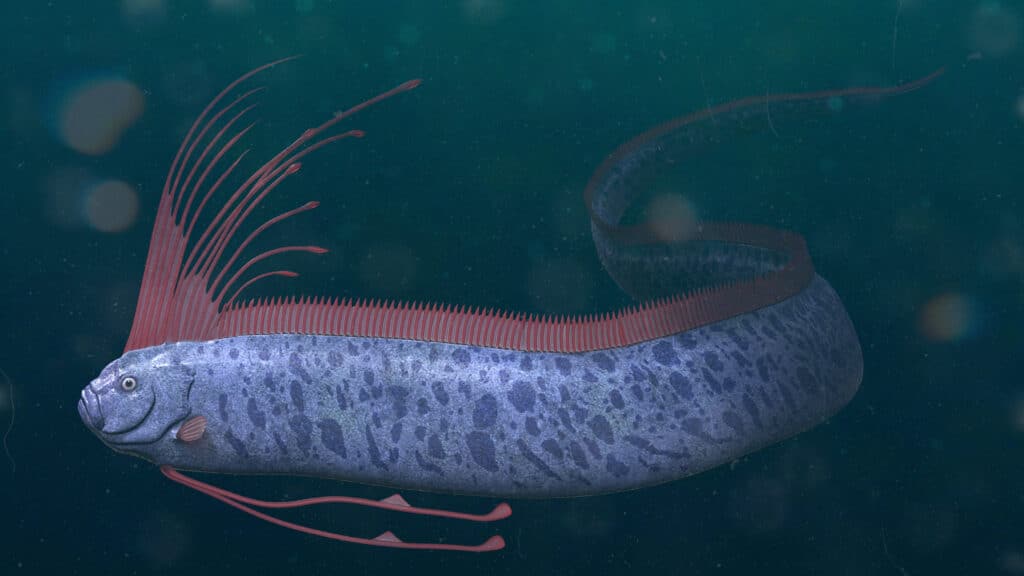
If the giant oarfish doesn’t look like a dragon, nothing does.
©Dotted Yeti/Shutterstock.com
If any fish gave a sailor the idea that there were dragons in the deep, the oarfish is it. Indeed, if this behemoth didn’t remind one of dragons, it certainly gave rise to the myth of the dragon’s first cousin, the sea serpent. The oarfish, whose scientific name is Regalecus glesne, can grow to 36 feet in length and fairly regularly washes up on the beach or floats to the surface of the ocean when it’s in extremis.
What It Looks Like
The oarfish has a long, flat, tapering body with a dorsal fin that runs down its entire length. It has a small, toothless mouth. The first dozen or so dorsal fins, which sprout from the top of the head, form a long crest. The fish’s pelvic fins are also very long, and each has between one and five rays. The oarfish’s pectoral fins are small, it lacks an anal fin, and the caudal fin might also be absent or very small. None of the fish’s fins have spines. The end of the fish is supposed to be a point, but bodies are sometimes found with stumpy tails. Some biologists believe this is because the fish amputated its tail to avoid predators, much like a lizard.
The fish lacks scales, but its skin is fragile and covered with ganoine. This is a covering made of apatite crystals that give the body a glassy shimmer. The fish has an overgrowth of bone that’s believed to protect its spine as it undulates its huge body through the water. The bony structures also provide support to the dorsal fins that keep the fish buoyant since it lacks a swim bladder.
Where It’s Found
Oarfish are found in warm oceans all over the world, usually from 660 to 3,300 feet down. The ocean currents stop that far down, so the fish doesn’t have an opportunity to build muscle mass to help it swim, and its flesh is jelly-like. Because of this, strong currents in the upper ocean kill or injure the oarfish.
These fish eat zooplankton, small fish, jellyfish, and squid. It protrudes its mouth and sucks prey out of the water. In turn, this huge fish is itself prey to large or very bold ocean predators. Scientists don’t know the fish’s courtship practices. However, females can release millions of colorful eggs at a time. These eggs are light enough to float in the water column and become part of the zooplankton that the oarfish eats.
2. Anglerfish
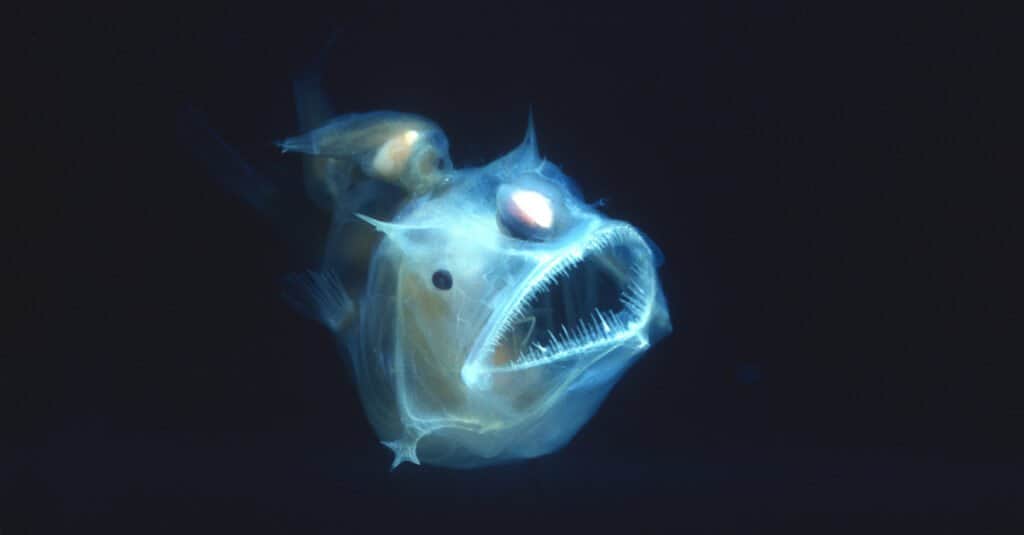
Female
anglerfish
are much larger than the males.
©Neil Bromhall/Shutterstock.com
This fish, with its mouthful of needlelike, dragon teeth, looks ferocious and to its prey it certainly is. Anglerfish were given their name because they have an esca, or a fin ray, that acts like a fishing rod. A light at the end of the ray attracts prey, which are then devoured.
The common or humpback anglerfish, Melanocetus johnsonii, is found in warm seas all around the world between depths of 330 and 4,920 feet, though it’s most often found in shallow water. Even at 330 feet sunlight is scarce, and this fish that looks like a dragon needs bioluminescence to lure prey. The light at the tip of the esca is caused not by a property of the fish itself but by Enterovibrio escacola bacteria.
Females and Males
When you see a common anglerfish with its lure and rows of teeth, you’re looking at a female. The males are tiny, only between 0.61 and 1.1 inches long. Despite her fearsome appearance and the fact that her genus name means “black whale,” the female isn’t that big either. She only grows to around 6 inches in length. Her body is round, and her head is huge. Her fang-filled mouth is wide enough and her stomach stretchy enough for her to gulp down prey bigger than she is. Because she swims in darkness, her eyes are tiny. She doesn’t hunt but waits for prey to come near before she lunges and snatches them.
In other anglerfish, the much smaller male latches on to a female and eventually fuses with her body. However, a common anglerfish male attaches to a female long enough to donate sperm, which he releases into the water as she releases eggs. Then he leaves and finds another female. The conservation status of the wide-ranging common anglerfish is least concern.
3. Seahorse
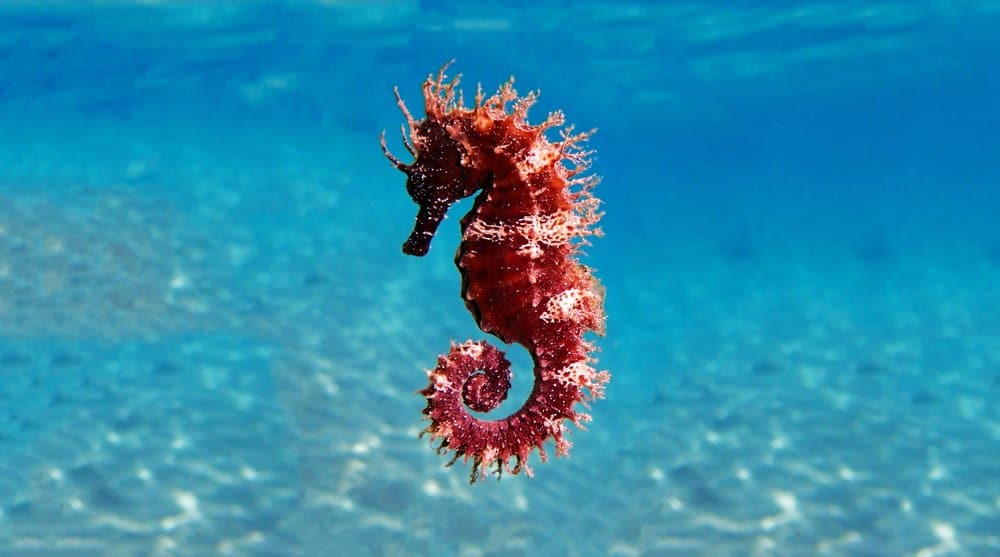
Seahorses look like little dragons, and the male is the one who gets pregnant.
©Vojce/Shutterstock.com
The seahorse’s genus name, Hippocampus, means “horse/sea monster,” and the shape of this fish does put people in mind of a tiny dragon. Its body is armored, as dragons are said to be, and it has a long, prehensile tail. There are 46 species of seahorse, and they’re found all around the world in both tropical and temperate bodies of salt water.
Seahorses can be tiny, and some are a little over half an inch long. Others can be close to 14 inches long. They are one of only two types of fish that swim upright and one of a few that actually has a neck that can easily flex. Seahorses also resemble dragons in that they may sport a horn or a coronet on their head. Though they have dorsal fins, seahorses don’t have caudal fins. Their pectoral fins, which are usually found behind the gills of other fish, are behind their eyes. Not surprisingly, seahorses are bad swimmers, so they’re usually found clinging to something with their tails.
These fish are ambush predators and use their long snouts to eat, but they lack stomachs and must eat all the time. They are excellent at camouflage. This allows potential prey such as tiny crustaceans, fish larvae, copepods, and other types of marine invertebrates to get too close.
Reproduction
Seahorses have a unique reproductive strategy. First, it involves a very elaborate courtship ritual that can last for days. Finally, the female deposits her eggs in the male’s brood pouch where his sperm fertilizes them with the help of seawater. The brood pouch both protects and provides nutrients for the embryos as they develop. The eggs, which usually number from 100 to 1,000 hatch inside the pouch. The male gives birth to the fry, usually at night, by pumping them out. Despite all of this, seahorse fry are on their own after they’re born, and the parents provide no more care. Though 95.5 percent of seahorse fry don’t live to adulthood, their survival rate is actually higher than others thanks to their father’s care.
4. Stoplight Loosejaw
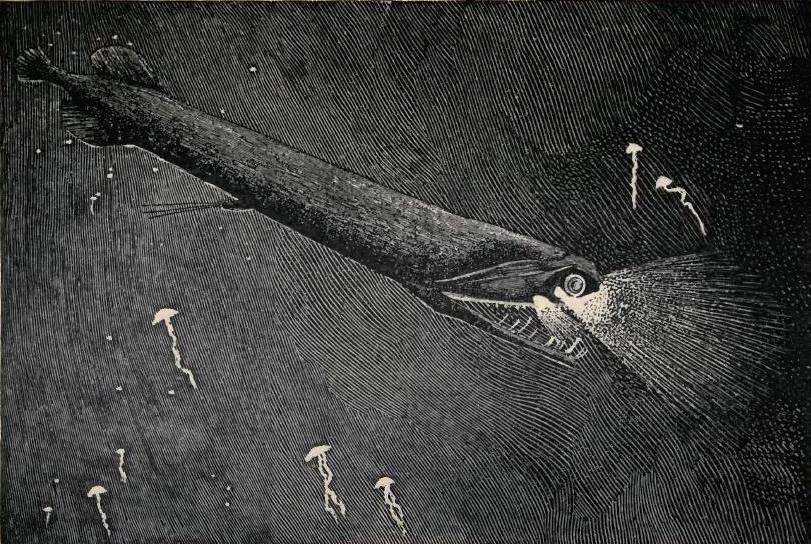
The stoplight loosejaw and its close relatives are the only fish with red bioluminescence.
©Living lights : a popular account of phosphorescent animals and vegetables (1887) Archive.org-living lights p.132-133 – License
Another name for this fish and its relatives is dragonfish. These fish are small, only between 6 and 10 inches long, but they’re apex predators. The reason for this is that they can open their jaws wider than nearly any other animal, and those jaws are filled with fangs. They get their name not just because their jaw is “loose” but because they create a red and green bioluminescence that remind people of a stoplight. Fish in its genus, Malacosteus, are the only animals in the world that create red bioluminescence. There are two species, M. australis and M. niger.
The stoplight loosejaw is found in all the oceans. They usually swim lower than 1,600 feet. Unlike their relatives in the Stomiidae family, they don’t travel upwards during the night and return to the depths during the day. This migration is called diel vertical migration.
What It Looks Like
This fish that looks like a dragon has a long, tapering body, a blunt nose, and huge, forward-facing eyes. It has no scales and is patent leather black. The length of the lower jaw is 25 percent of the length of the fish’s body, and the lower jaw doesn’t have a floor. Besides the fangs in the mouth, the fish actually has teeth in its throat to help pass food into its digestive system. A photophore beneath its eye produces red light, and the photophore behind it makes green light. You can tell males from females because this photophore is larger in males. There’s another tiny photophore between the eye and the red photophore, and there are constellations of blue and white photophores around the rest of the fish’s body.
Since most creatures that live in the deep can’t see red light, the stoplight loosejaw can hunt without being seen. Interestingly, though this fish can swallow prey half its size, it usually dines on plankton, smaller fish, and crustaceans. Scientists do not know how the fish does this with a hole in its lower jaw.
5. Leafy Seadragon
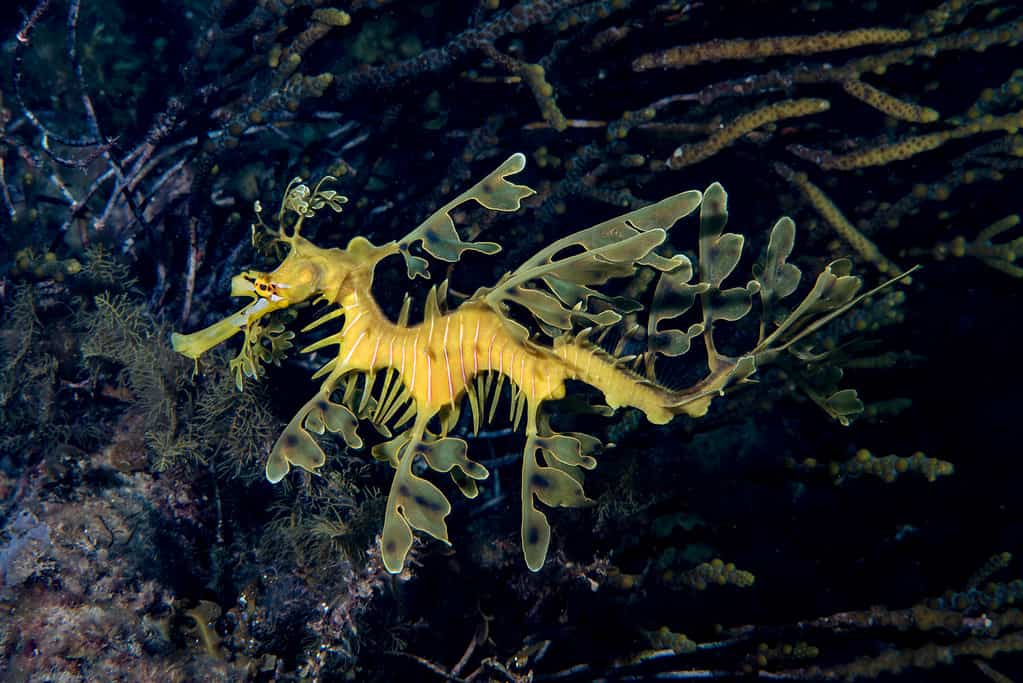
The leafy seadragon’s “leaves” help camouflage it among floating seaweed.
©Francesco_Ricciardi/Shutterstock.com
Though it is related to the seahorse and resembles one, the leafy seadragon is in a separate genus. This is Phycodurus, and the leafy seadragon is the only member.
The leafy seadragon is found around the coasts of southern Australia and gets its appearance from the leaf-like structures found over its body. The fish uses them to mimic floating seaweed and uses its pectoral and dorsal fins to swim. Its genus name means “seaweed skin” in Greek. It’s between 8 and 9.5 inches long. The fish eats plankton and other invertebrates such as tiny shrimp, fish larvae, and amphipods. Like the seahorse, it sucks them up using its snout.
This fish that looks like a dragon is also like the seahorse in that the male takes care of the eggs. The female sticks about 250 eggs on the male’s tail then the eggs stick to a brood patch. They hatch after about nine weeks, and the father helps by shaking his tail. The fry are then completely independent. The leafy seadragon is south Australia’s marine emblem.
The photo featured at the top of this post is © Dotted Yeti/Shutterstock.com
Thank you for reading! Have some feedback for us? Contact the AZ Animals editorial team.






